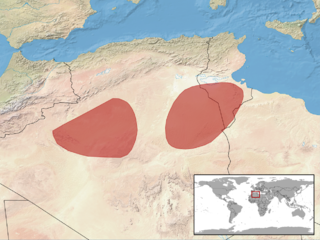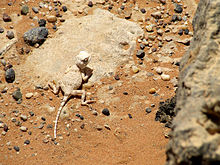
The International Union for Conservation of Nature (IUCN) Red List of Threatened Species, founded in 1964, is the world's most comprehensive inventory of the global conservation status of biological species. It uses a set of criteria to evaluate the extinction risk of thousands of species and subspecies. These criteria are relevant to all species and all regions of the world. With its strong scientific base, the IUCN Red List is recognized as the most authoritative guide to the status of biological diversity. A series of Regional Red Lists are produced by countries or organizations, which assess the risk of extinction to species within a political management unit.

"Sardine" and "pilchard" are common names that refer to various small, oily forage fish in the herring family Clupeidae. The term "sardine" was first used in English during the early 15th century and may come from the Mediterranean island of Sardinia, around which sardines were once abundant.

Trapelus is a genus of Middle Eastern agamid lizards, which contains 13 species.

Python is a genus of constricting snakes in the Pythonidae family native to the tropics and subtropics of the Eastern Hemisphere.

The wildlife of Kazakhstan includes its flora and fauna, and their natural habitats.

A species that is extinct in the wild (EW) is one that has been categorized by the International Union for Conservation of Nature as known only by living members kept in captivity or as a naturalized population outside its historic range due to massive habitat loss.
This article is a list of biological species and subspecies that are known to have become extinct during the Holocene, the current geologic epoch, ordered by their known or approximate date of disappearance from oldest to most recent.

Savigny's agama is a species of lizard in the family Agamidae. The species is native to the Levant.

The erg agama, also commonly known as the Sahara agama, is a species of lizard in the family Agamidae. The species is endemic to North Africa.

The Somali hedgehog is a species of mammal in the family Erinaceidae. It is endemic to Somalia. The Somali hedgehog is nocturnal.

The yellow-spotted agama is a common species of agamid lizard endemic to the Middle East.

The World's 25 Most Endangered Primates is a list of highly endangered primate species selected and published by the International Union for Conservation of Nature Species Survival Commission Primate Specialist Group, the International Primatological Society (IPS), and Conservation International (CI). The 2012–2014 list added the Bristol Conservation and Science Foundation (BCSF) to the list of publishers. The IUCN/SSC PSG worked with CI to start the list in 2000, but in 2002, during the 19th Congress of the International Primatological Society, primatologists reviewed and debated the list, resulting in the 2002–2004 revision and the endorsement of the IPS. The publication has since been a joint project between the three conservation organizations and has been revised every two years following the biannual Congress of the IPS. Starting with the 2004–2006 report, the title changed to "Primates in Peril: The World's 25 Most Endangered Primates". That same year, the list began to provide information about each species, including their conservation status and the threats they face in the wild. The species text is written in collaboration with experts from the field, with 60 people contributing to the 2006–2008 report and 85 people contributing to the 2008–2010 report. The 2004–2006 and 2006–2008 reports were published in the IUCN/SSC PSG journal Primate Conservation, while the 2008–2010 and 2010-2012 report were published as independent publications by all three contributing organizations.

Endangered species as classified by the International Union for Conservation of Nature (IUCN), are species which have been categorized as very likely to become extinct in the near future. On the IUCN Red List, endangered is the second most severe conservation status for wild populations in the IUCN's schema after Critically endangered (CR). In 2012, the IUCN Red List featured 3,079 animal and 2,655 plant species as endangered (EN) worldwide. The figures for 1998 were 1,102 and 1,197 respectively.

Trapelus mutabilis, the desert agama, is a species of agama found in Morocco, Mauritania, Western Sahara, Algeria, Tunisia, Libya, Egypt, Mali, Iraq, Chad, Sudan, and Saudi Arabia.
Trapelus persicus, Olivier's agama or Baluch ground agama, is a species of agama found in Syria, Lebanon, Jordan, Saudi Arabia, Iraq, and Iran.

Trapelus ruderatus, Olivier’s agama or Baluch ground agama, is a species of agama found in Azerbaijan, Syria, Lebanon, Jordan, Saudi Arabia, Iraq, Iran, and Pakistan.

Trapelus sanguinolentus, the steppe agama, is a species of agama found in Russia, Kazakhstan, Kyrgyzstan, Tajikistan, Iran, Afghanistan, and China.
Trapelus schmitzi, Schmitz's agama, is a species of agama found in Chad and Algeria.
















